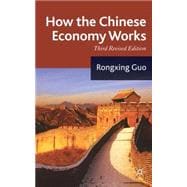
Note: Supplemental materials are not guaranteed with Rental or Used book purchases.
Purchase Benefits
Looking to rent a book? Rent How the Chinese Economy Works [ISBN: 9780230581005] for the semester, quarter, and short term or search our site for other textbooks by Guo, Rongxing. Renting a textbook can save you up to 90% from the cost of buying.
| List of Boxes | p. xi |
| List of Figures | p. xii |
| List of Tables | p. xiv |
| List of Abbreviations | p. xvi |
| Foreword | p. xviii |
| Preface | p. xx |
| Key Terms | p. xxv |
| Map | p. xxviii |
| A Brief History of China | p. 1 |
| The origins of the nation | p. 1 |
| Rise and fall of the empire | p. 3 |
| China in the new millennium | p. 9 |
| Summary | p. 11 |
| Case study: Why the Yellow river is important | p. 12 |
| Spatial and Administrative Divisions | p. 16 |
| Administrative divisions | p. 16 |
| Great regions | p. 21 |
| Geographical belts | p. 23 |
| Southern and northern parts | p. 25 |
| Ethno-cultural areas | p. 26 |
| Summary | p. 29 |
| Case study: Who owns Lake Weishan? | p. 30 |
| Human and Cultural Contexts | p. 38 |
| Population | p. 38 |
| Labor force | p. 44 |
| Education | p. 45 |
| Cultural context | p. 50 |
| Summary | p. 58 |
| Case study: Age, gender, education and earnings | p. 59 |
| Political Economic Systems in Transition | p. 66 |
| Plan and market | p. 66 |
| Employment | p. 72 |
| Production and ownership | p. 75 |
| Public finance | p. 82 |
| Banking | p. 87 |
| External relations | p. 91 |
| Summary | p. 94 |
| Case study: System dynamics - a feedback model | p. 96 |
| Understanding Chinese Economic Reform | p. 99 |
| A brief narrative | p. 99 |
| Interest groups and stakeholders | p. 103 |
| Radical reform: the (un)successful cases | p. 110 |
| Gradual/partial reform: the (un)successful cases | p. 114 |
| Whither Chinese-style reform? | p. 120 |
| Summary | p. 127 |
| Case study: Games between radicals and conservatives | p. 128 |
| Economic Growth and Income Distribution | p. 136 |
| China's growth performance | p. 136 |
| Measuring income inequality | p. 141 |
| Inequality: causes and consequences | p. 144 |
| Poverty and social security | p. 149 |
| Summary | p. 152 |
| Case study: A tale of two companies in transition | p. 153 |
| A Multiregional Economic Comparison | p. 163 |
| About the statistical data | p. 163 |
| Macroeconomic performance | p. 166 |
| Real living standards | p. 170 |
| Regional economic disparity | p. 177 |
| Summary | p. 183 |
| Case study: Similar initial conditions, varied results | p. 185 |
| Spatial Economics and Development Strategy | p. 187 |
| Comparative advantage index | p. 187 |
| Spatial economic separation | p. 192 |
| China's search for spatial integration | p. 198 |
| Regional development strategy | p. 201 |
| Summary | p. 205 |
| Case study: Fighting for rainfalls? | p. 206 |
| Industrialization and Technological Progress | p. 212 |
| China's industrialization efforts | p. 212 |
| Post-reform industrialization | p. 219 |
| A comparative analysis | p. 226 |
| Technological progress | p. 230 |
| Summary | p. 235 |
| Case study: Technological and economic leapfrogging | p. 235 |
| The Quest for Sustainable Development | p. 238 |
| Background | p. 238 |
| Natural resources | p. 242 |
| Energy production and consumption | p. 247 |
| Environmental situation | p. 251 |
| Chinese environmental policy | p. 259 |
| Summary | p. 264 |
| Case study: Should Chinese legislations be revised? | p. 265 |
| International Economic Influences | p. 268 |
| Historical review | p. 268 |
| Foreign direct investment | p. 276 |
| Foreign trade | p. 281 |
| A quantitative analysis | p. 285 |
| Summary | p. 290 |
| Case study: Cultural influences on foreign trade | p. 291 |
| The Greater China Area: Retrospect and Prospect | p. 296 |
| Historical evolution | p. 296 |
| Social and economic differences | p. 300 |
| Complementary conditions | p. 303 |
| Cross-Strait economic relations | p. 305 |
| Future perspective | p. 312 |
| Case study: Overseas Chinese economics | p. 313 |
| Appendixes | |
| Basic Conditions of the Ethnic Minorities | p. 315 |
| A List of Major Reforms From 1978 to 2008 | p. 317 |
| Notes | p. 319 |
| Bibliography | p. 362 |
| Index | p. 361 |
| Table of Contents provided by Ingram. All Rights Reserved. |
The New copy of this book will include any supplemental materials advertised. Please check the title of the book to determine if it should include any access cards, study guides, lab manuals, CDs, etc.
The Used, Rental and eBook copies of this book are not guaranteed to include any supplemental materials. Typically, only the book itself is included. This is true even if the title states it includes any access cards, study guides, lab manuals, CDs, etc.